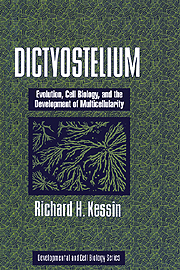Book contents
- Frontmatter
- Contents
- Preface
- 1 A Brief Introduction to Dictyostelium discoideum and its Relatives
- 2 A History of Research on Dictyostelium discoideum
- 3 The Evolutionary Biology of Dictyostelium
- 4 The Genome and Genetics
- 5 Membranes and Organelles of Dictyostelium
- 6 Cell Motility and the Cytoskeleton
- 7 The Transition from Growth to Development: From Starvation to Self-Sustaining cAMP Signal Relay
- 8 Chemotaxis and Aggregation
- 9 Differentiation and Adhesion in the Aggregate
- 10 The Behavior of Cells in the Slug
- 11 Culmination
- 12 Formation and Germination of Spores
- 13 Resources
- References
- Index
- Plate section
6 - Cell Motility and the Cytoskeleton
Published online by Cambridge University Press: 07 October 2009
- Frontmatter
- Contents
- Preface
- 1 A Brief Introduction to Dictyostelium discoideum and its Relatives
- 2 A History of Research on Dictyostelium discoideum
- 3 The Evolutionary Biology of Dictyostelium
- 4 The Genome and Genetics
- 5 Membranes and Organelles of Dictyostelium
- 6 Cell Motility and the Cytoskeleton
- 7 The Transition from Growth to Development: From Starvation to Self-Sustaining cAMP Signal Relay
- 8 Chemotaxis and Aggregation
- 9 Differentiation and Adhesion in the Aggregate
- 10 The Behavior of Cells in the Slug
- 11 Culmination
- 12 Formation and Germination of Spores
- 13 Resources
- References
- Index
- Plate section
Summary
If Dictyostelium amoebae are not the Ferraris of moving cells, they are at least a respectable entrant in the cell motility Grand Prix. Amoebae can move as fast as 10–15 μm/min (Varnum and Soll, 1984). They do not do this in a random walk, but move directionally, up gradients of cAMP or folate. D. discoideum responds to gradients that vary by as little as 2% from the front to the back of a cell, as we will describe in Chapter 8. This astonishing chemical sensitivity raises a number of questions. How are signal transduction pathways connected to the cytoskeleton such that stimulation of chemotactic receptors leads to movement up a chemical gradient? How are the components of the cytoskeleton organized to promote sudden movement of cells? How does the mobilization of the cytoskeleton differ in the various protrusions, such as pseudopodia and fllopodia? How are responses terminated? In this chapter we will review how the actin-based cytoskeleton is mobilized during cell movement, while in Chapter 8 we will consider how it reorganizes to drive the cells up a gradient of cAMP, toward centers of aggregation.
Dictyostelium is one of the few organisms with impressive motility and tractable genetics. The cells move toward folate during growth and toward cAMP during development. The amoebae are useful for optical observation, so that with a few tricks, the movements of macromolecules within the cells can be observed by a variety of microscopic methods.
- Type
- Chapter
- Information
- DictyosteliumEvolution, Cell Biology, and the Development of Multicellularity, pp. 70 - 88Publisher: Cambridge University PressPrint publication year: 2001



